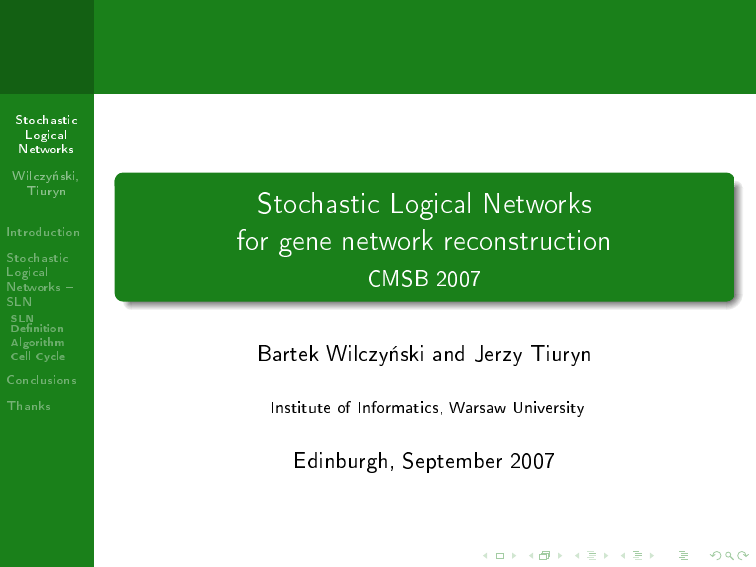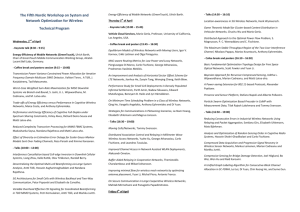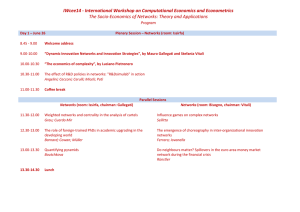Document 13355364
advertisement

Stohasti
Logial
Networks
Wilzy«ski,
Tiuryn
Introdution
Stohasti
Logial
Networks SLN
SLN
Denition
Algorithm
Cell Cyle
Stohasti Logial Networks
for gene network reonstrution
CMSB 2007
Bartek Wilzy«ski and Jerzy Tiuryn
Conlusions
Thanks
Institute of Informatis, Warsaw University
Edinburgh, September 2007
Gene network reonstrution informal problem
statement
Stohasti
Logial
Networks
Wilzy«ski,
Tiuryn
Introdution
Stohasti
Logial
Networks SLN
SLN
Denition
Algorithm
Cell Cyle
Conlusions
Thanks
Reovering the struture of regulatory dependenies between
genes from experimental gene produt onentration ratios from
miro arrays or proteomis
in:
Very
indiret
and
noisy
data on gene produt (mRNA)
onentrations
out:
Usually representing regulatory dependenies struture as a
direted (possibly labelled) graph.
Gene network reonstrution informal problem
statement
Stohasti
Logial
Networks
Wilzy«ski,
Tiuryn
Introdution
Stohasti
Logial
Networks SLN
SLN
Denition
Algorithm
Cell Cyle
Conlusions
Thanks
Reovering the struture of regulatory dependenies between
genes from experimental gene produt onentration ratios from
miro arrays or proteomis
in:
Very
indiret
and
noisy
data on gene produt (mRNA)
onentrations
out:
Usually representing regulatory dependenies struture as a
direted (possibly labelled) graph.
Even inomplete models may be valuable for experimenters.
The ost of omputations has to be reasonable.
Dierent approahes same old problems
Stohasti
Logial
Networks
Wilzy«ski,
Tiuryn
Introdution
Stohasti
Logial
Networks SLN
SLN
Denition
Algorithm
Cell Cyle
Conlusions
Thanks
(Dynami) Bayesian Networks
(Friedman et al, Husmeier, Dojer et al.)
(Probabilisti) Boolean Networks (Shmulevih et al.)
(Stohasti) Dierential Equations (Chen et al.)
Rule based models (Brutlag et al., Pham et al., Hvidsten et al.)
Problems
Diult (often NP-hard) to nd a solution
Even heuristi algorithms are omputationaly expensive
Often hard to hoose from many possible solutions
Stohasti Logial Networks
Stohasti
Logial
Networks
Wilzy«ski,
Tiuryn
Introdution
Stohasti
Logial
Networks SLN
SLN
Denition
Algorithm
Cell Cyle
Conlusions
Thanks
Based on the Kineti Logi modelling of R.Thomas (1973)
Extending the Thomas modelling by adding random noise
to the regulation funtion
Coupled ontinuous and disrete system: Stohasti
Dierential Equations and Markov hain with spei state
spae
Disretization: ontinuous vs. disrete networks
Stohasti
Logial
Networks
Wilzy«ski,
Tiuryn
Introdution
Stohasti
Logial
Networks SLN
SLN
Denition
Algorithm
Cell Cyle
Conlusions
Thanks
Stohasti Dierential equations
Stohasti
Logial
Networks
Wilzy«ski,
Tiuryn
Real valued onentration vetor
Introdution
Stohasti regulatory funtion:
Stohasti
Logial
Networks SLN
SLN
Denition
Algorithm
Cell Cyle
where
Conlusions
from Thomas modelling,
Thanks
~v (t ) = {v1 , v2 , . . . , vn }
∂ vi
= Fi (~v (t )) − λi vi + ηi (t ),
∂t
ηi
ηi
Fi (~v (t ))
is the deterministi regulatory funtion inherited
λi
is a degradation onstant of gene i , and
desribes the noise term for gene i .
are assumed to be independent of eah other and independent of
the urrent state of the system.
Disrete SLN model
Stohasti
Logial
Networks
Wilzy«ski,
Tiuryn
regulatory graph (direted)
ΣN = {0..n}n ,
For eah state
Introdution
Stohasti
Logial
Networks SLN
SLN
Denition
Algorithm
Cell Cyle
σ ∈ ΣN
we dene its neighbours
σ ′ ⇔ D(σ, σ ′ ) ≤ 1
011 but 010
The transition matrix
A
6
111
of the Markov hain must satisfy
the ondition
Conlusions
Thanks
the state spae of the Markov hain
σ
e.g. 010
N = hV , E i, |V | = n
σ
σ ′ ⇔ Aσσ′ > 0
The Markovian assumption follows from the simplifying
assumption that all states orresponding to the same
disrete state should be onsidered the same. Other
approah to this problem involve inorporating delays
(Siebert et al.)
The system may show long-time dependenies
Stohasti
Logial
Networks
Wilzy«ski,
Tiuryn
Introdution
Stohasti
Logial
Networks SLN
SLN
Denition
Algorithm
Cell Cyle
Conlusions
Thanks
Witness states of a regulatory interation
Stohasti
Logial
Networks
Wilzy«ski,
Tiuryn
Introdution
Stohasti
Logial
Networks SLN
SLN
Denition
Algorithm
Cell Cyle
Conlusions
Thanks
States
σ, σ ′
witness the regulation
i
→j
if
Pr (σ,j ,↑) 6= Pr (σ′ ,j ,↑)
Pr (σ,j ,↓)
Pr (σ′ ,j ,↓)
The reonstrution algorithm
Stohasti
Logial
Networks
Wilzy«ski,
Tiuryn
In the earlier work (CMSB 2006) we estimated the parameters from
time-series data, and then searhed for witness states. This
resulted in an exponential omplexity (both time and memory).
Introdution
However, we do not have to onsider the states not ouring in
Stohasti
Logial
Networks SLN
SLN
Denition
Algorithm
Cell Cyle
our data.
Conlusions
Thanks
Use state hange frequenies from data instead of the
probabilities
For all
witness
states
ourring
in the data, report a
regulatory interation.
For edges that have a witness, nd the sign of interation
(ativator or repressor)
The omputation ost is
dataset and
n
O(d 2 · n),
where
is the number of genes.
d
is the size of the
Reonstruting a simple feedbak iruit
Stohasti
Logial
Networks
Wilzy«ski,
Tiuryn
Introdution
Stohasti
Logial
Networks SLN
SLN
Denition
Algorithm
Cell Cyle
Conlusions
Thanks
Simulated expression and networks reonstruted with SLNs
and Bayesian Networks
Simulating gene expression data
Stohasti
Logial
Networks
Wilzy«ski,
Tiuryn
Introdution
Stohasti
Logial
Networks SLN
SLN
Denition
Algorithm
Cell Cyle
Conlusions
Thanks
Another feedbak iruit
Stohasti
Logial
Networks
Wilzy«ski,
Tiuryn
Introdution
Stohasti
Logial
Networks SLN
SLN
Denition
Algorithm
Cell Cyle
Conlusions
A reonstrution of a simulated network omposed from 3
feedbak loops ontaining 4 genes eah.
reonstruted with SLNs
A
B
E
F
J
K
D
C
H
G
M
L
reonstruted with DBNs
Thanks
A
B
E
F
J
K
D
C
H
G
M
L
Assessing the signiane of reonstrution
Stohasti
Logial
Networks
Wilzy«ski,
Tiuryn
Introdution
Stohasti
Logial
Networks SLN
SLN
Denition
Algorithm
Cell Cyle
Conlusions
Thanks
In order to measure the quality of the reonstruted network,
we ompare it with the true (or postulated) network and report
the following measures:
Sensitivity:
Speiity:
p −value
TP
TP +FN
TN
TN +FP
in the Binomial model the probability of getting the same or
higher number of
TP + TN assuming that we are seleting the edges randomly with
probability 1/3 of getting a single orret edge with a proper sign.
We ompare the results obtained with our method with the
ones obtained with Dynami Bayesian Networks, using the exat
algorithm by Dojer (2006) for BDe and MDL soring funtions.
The ase study human ell yle model
Stohasti
Logial
Networks
Wilzy«ski,
Tiuryn
As a referene system, we have hosen the model of the
network regulating the mammalian ell yle, as desribed by
Faure, Naldi, Chaouia and Thiery, Bioinformatis, 2006
Introdution
Stohasti
Logial
Networks SLN
SLN
Denition
Algorithm
Cell Cyle
Conlusions
Thanks
gures taken from the Faure et al., Bioinformatis 2006
Network inferred from Boolean states
Stohasti
Logial
Networks
Wilzy«ski,
Tiuryn
Introdution
Stohasti
Logial
Networks SLN
SLN
Denition
Algorithm
Cell Cyle
Conlusions
Thanks
As input, we take the 19 states onstituting the trajetory
of the 10 key genes during the ell yle.
The true network onsists of 10 genes and has 38 edges
The dynamis of the network is not exatly the same as in
our model, sine Faure et al. hose to use a
semi-synhronous approah to state transitions.
Edges
TP(signed)
28
18 (16)
DBN(BDe)
16
8 (7)
DBN(MDL)
22
13 (11)
method
SLN
p-value
· 10−11
−8
2.9 · 10
−9
2.8 · 10
1.6
Sens.
Spe.
0.47
0.84
0.21
0.87
0.34
0.84
Network inferred from miroarray data
Stohasti
Logial
Networks
Wilzy«ski,
Tiuryn
Introdution
Stohasti
Logial
Networks SLN
SLN
Denition
Algorithm
Cell Cyle
Conlusions
Thanks
Miroarray data from tumor ell lines
2002, Mol. Biol. Cell),
(Whiteld et al.
5 time-series, 106 hips altogether
We assume the true network topology is the same as the
one proposed by Faure et al.
Two genes (Cylin A and Cadherin 1) were not measured
so we have to remove them from analysis together with all
their onnetions, whih leaves 8 verties and 20 edges.
Edges
TP (signed)
19
7 (5)
DBN(BDE)
16
6 (3)
DBN(MDL)
39
12 (6)
method
SLN
p-value
· 10−4
−4
7.0 · 10
−1
8.9 · 10
2.9
Sens.
Spe.
0.35
0.73
0.30
0.73
0.60
0.39
Reonstrution from kineti model
Stohasti
Logial
Networks
Wilzy«ski,
Tiuryn
Introdution
Stohasti
Logial
Networks SLN
SLN
Denition
Algorithm
Cell Cyle
Conlusions
Thanks
Data simulated from a kineti (ODE) model published by
Novak and Tyson (JTB, 2004), 150 points, 3 yles, 10
genes represented by the disretized mRNA onentration.
8 genes, 27 edges in the postulated topology
method
Edges
TP(signed)
p-value
Sens.
Spe.
−2
4.7 · 10
−2
7.8 · 10
0.51
0.59
0.33
0.70
· 10−2
0.44
0.65
SLN
29
14 (10)
DBN(BDe)
20
9 (5)
DBN(MDL)
25
12 (8)
4.7
Conlusions
Stohasti
Logial
Networks
Wilzy«ski,
Tiuryn
Introdution
Reonstrution quality is far from perfet, but is
Stohasti
Logial
Networks SLN
SLN
Denition
Algorithm
Cell Cyle
omparable with Dynami Bayesian Networks
Conlusions
Thanks
Very eient algorithm
May report inomplete models
Sensitive to large gaps in the measured trajetories
Requires substantial size of dataset
Aknowledgments
Stohasti
Logial
Networks
Wilzy«ski,
Tiuryn
Introdution
Norbert Dojer
Stohasti
Logial
Networks SLN
SLN
Denition
Algorithm
Cell Cyle
We reeived support from Polish Ministry of Siene and Polish
Conlusions
Siene Foundation
Thanks
Ania Gambin
Jaek Mikisz


